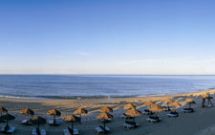Medieval Vila Real
Medieval Vila Real
Other
Located on the southern side of the current city was the original "royal town" founded by king Dinis.
Although practically all the original town has since disappeared, the area is impressive for the beauty of its views.
Half an hour is about right to walk the promenade that begins at Largo do Freitas. This was where one of the main gates to the town was located defended by two towers demolished in the 19th century.
On the western side, some 100 metres down, runs the river Cabril. On the eastern side, over in the distance, there is the deep ravine containing the river Corgo. The two rivers converge to the extreme south of the promenade where it is still possible to discern some remains of the medieval wall that Dinis had built.
In the distance, there are the mountains that surround Vila Real: the Montemuro range to the south, the peak of Serra does Marão to the west and the rolling hills of Alvão to the northeast.
Within the walls are the S. Brás (Saint Bras) chapel cemetery, and the adjoining church of S. Dinis (Saint Denis), dating back to the founding of Vila Real.
Head down Rua de Traz do Muro, where the view takes in the Corgo valley whose waters feed a dam that was the first electric power station built by a municipal council in Portugal (1834). From this viewpoint, also resting on the old walls, there is the chapel of Santo António dos Esquecidos (Saint Anthony of the Forgotten) built in the mid-17th century. From there return to the Largo dos Freitas to begin a tour of old Vila Real at the Paços do Concelho (Town Hall) at the end of Avenida Carvalho Araújo.
Although practically all the original town has since disappeared, the area is impressive for the beauty of its views.
Half an hour is about right to walk the promenade that begins at Largo do Freitas. This was where one of the main gates to the town was located defended by two towers demolished in the 19th century.
On the western side, some 100 metres down, runs the river Cabril. On the eastern side, over in the distance, there is the deep ravine containing the river Corgo. The two rivers converge to the extreme south of the promenade where it is still possible to discern some remains of the medieval wall that Dinis had built.
In the distance, there are the mountains that surround Vila Real: the Montemuro range to the south, the peak of Serra does Marão to the west and the rolling hills of Alvão to the northeast.
Within the walls are the S. Brás (Saint Bras) chapel cemetery, and the adjoining church of S. Dinis (Saint Denis), dating back to the founding of Vila Real.
Head down Rua de Traz do Muro, where the view takes in the Corgo valley whose waters feed a dam that was the first electric power station built by a municipal council in Portugal (1834). From this viewpoint, also resting on the old walls, there is the chapel of Santo António dos Esquecidos (Saint Anthony of the Forgotten) built in the mid-17th century. From there return to the Largo dos Freitas to begin a tour of old Vila Real at the Paços do Concelho (Town Hall) at the end of Avenida Carvalho Araújo.




 Explore
Explore 
 Remember and Share
Remember and Share 


